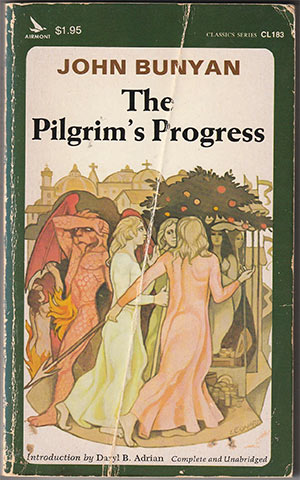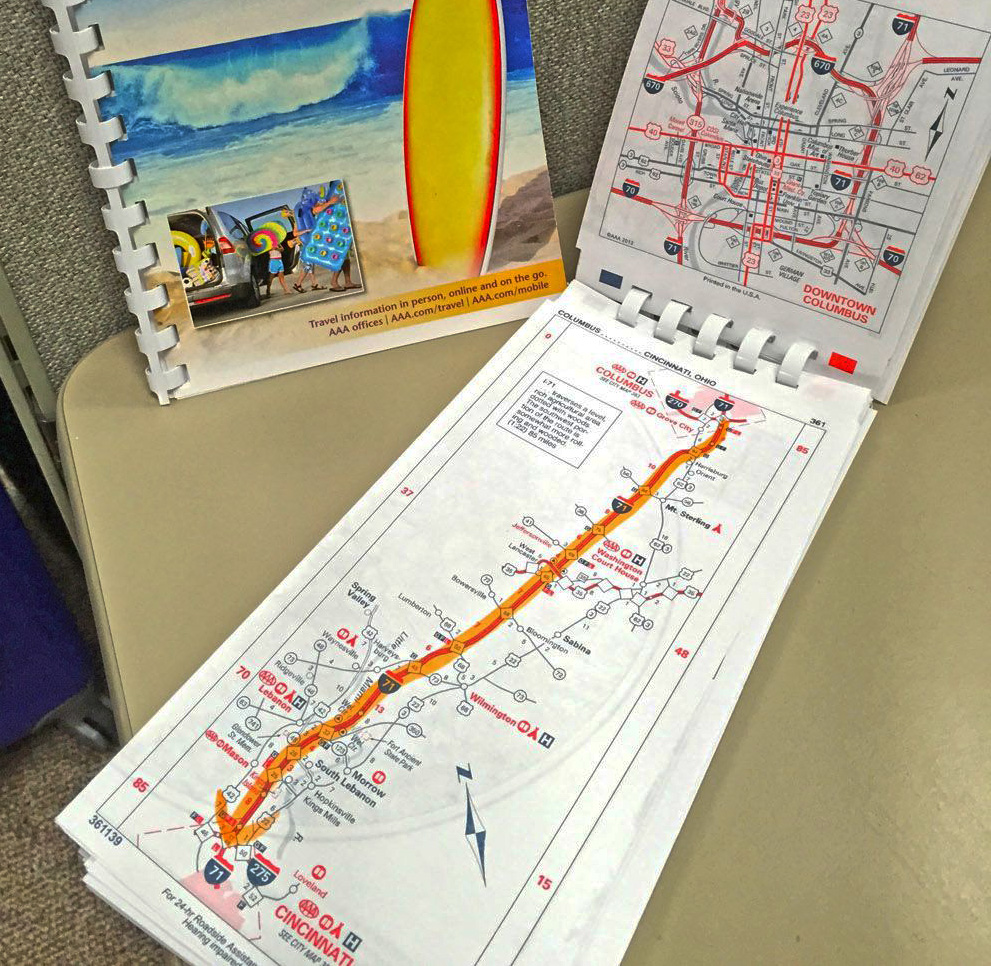I might have read The Pilgrim’s Progress before. There is evidence that points in this direction. Snug it sat there in my bookcase, my dilettante’s burden of paper-backed pages slung from slummy to safe to somewhat respectable address for twenty-five years.
As I pried it down dustily from venerated (nay, ignored) high-shelf perch, the sticker on the back cried out “USED $1.00! Courtesy of the College Bookstore.”
Based on this, I’d have to assume that Bunyan’s book was assigned for a sleepy-eyed eight-a-yem Western Civ class of some sort, where once purchased it surely sank unmolested to the bottom of my teal-green L. L. Bean nylon knapsack. And there it would have remained for the semester, the cover growing ever more sullied, the text still virginal, unsoiled by unseemly undergrad eyes, my freshman male gaze.
Back then I was pretty good at calculating the maximum return on my study hours, skilled at deciphering the minimum-effective-dose of nose-in-book activity. At the time, I was already familiar with Bunyan’s thin plot, having been entertained by dramatic readings of Christian’s plight through fair vanities and despondent sloughs at my evangelical primary school.
Armed with this knowledge — along with working definitions of fancy terms like “allegory” and “old” — my grip on the text would have sufficed to eke out a respectable essay, should such a need arise. Good enough for a Gen-Ed 101. In other words: I doubt I read it back then.
However, whether you’re versed in it or not, the influence of The Pilgrim’s Progress is hard to overstate. Published in 1678 — and widely considered the first novel written in English — it was the second tome the average home might have owned, or so we were told. If you could afford one book, then of course you bought The Word. If you could spare enough for another edition to enlighten your farmhouse or hovel, likely this it would have been.
Respect. So I didn’t complain when a revered senior member of The Book Club — a guy who always picks something salutary, if perhaps short on pizazz — chose it for an upcoming gathering. But flipping back through, I find I’ve got a bone to pick with Mr. Bunyan. You see, he got the “strait and narrow” thing wrong, and Christianity’s never been the same since. Let me explain.
Here’s the Gospel passage central to Bunyan’s conceit:
“Because strait is the gate, and narrow is the way, which leadeth unto life, and few there be that find it” (Matthew 7: 14, King James Version)
And here’s what Bunyan wrote:
CHRISTIAN: “But,” said Christian, “is there no turning nor windings, by which a stranger may lose the way?”
GOOD WILL: Yes, there are many ways but down upon this; and they are crooked and wide. But thus thou mayest distinguish the right from the wrong, that only being straight and narrow.”
Notice something odd there? The King James speaks of a “strait” gate and a “narrow” way. “Strait” isn’t a word we use much these days, but it means tight and difficult, or simply narrow. It survives as a nautical term for a navigable pass between larger bodies of water, in words like “straitjacket,” and in phrases like “dire straits.” Basically, the holy text is redundant, circling back on a key point as it often does for emphasis and poetic effect.
Bunyan, on the other hand, turns “strait” into “straight.” And if you’re tempted to let him off the hook for the slip, take a moment to note that he further amplifies the idea with descriptions of an unwavering path for the upright, free from “turnings nor windings.”
As a kid, the whole thing never made much sense to me. For two reasons.
First, on so many family excursions — staring at the scenery while tracing our path on the highlighted AAA TripTik — I’d always noticed that the inefficient old roads were the twisty, skinny ones. The new roads — the wide ones, the triumphant turnpikes constructed by Eisenhower’s decree — were always straighter, smoother, safer, and thus the wise route for those fearful of getting lost. Narrow equaled windy; wide went with straight. Not the other way around.
Secondly, the spiritual path, as I’ve experienced it — and as so many others have, from Moses to Merton to Augustine to Ram Dass — is a zig-zag affair. What spiritual journey is not scarred by seasons of fervor cut by dark nights of the soul? Or of moments of serendipity, of finding cosmic synchronicity in unplanned meanderings?
Anyway, I’d like to ask John Bunyan what he was thinking. It might have been an inadvertent slip of the mind, perhaps just a phonetic casualty from the age of pre-standard spelling. Or it may have been deliberate, the yielding homonym too tempting to ignore. Either way, Bunyan’s vision of the arrow-like, plumb path of the righteous entered the popular imagination and has crashed guilty waves of shame upon generations ever since.
But I wished I’d been reassured years ago that the path to enlightenment is strait, not straight. I would have felt differently about so many things, more forgiving of myself, and wasted far less time wallowing in shame-soaked flagellation.
Maybe you too? Here’s to the journey, pilgrim. Heaven awaits. It’s just around the bend.
Bonus Audio Feature! I’ve got a hunch that country pioneer Hank Williams got caught up in this confusion too. As he wrote in his much-loved tune, “I was a fool to wander and stray / Straight (Strait?) is the gate and narrow is the way / Now I have traded the wrong for the right / Praise the Lord, I saw the light.”
Hard to know which “Straight” Hank first scribbled down in his lyric book. I’ve seen it written both ways. Whichever way it was, “I Saw the Light” is a little bit of gospel crooning about turned corners and clean breaks. But if you take a look at his life, such sentiments were aspirational at best. In the end, he was taking it one step at a time, just like the rest of us.
Here’s my take on “I Saw The Light.” Enjoy!


